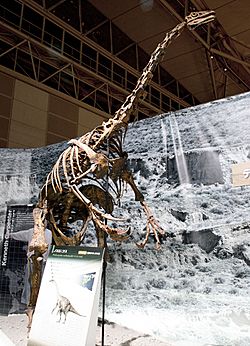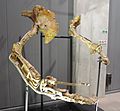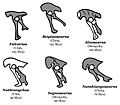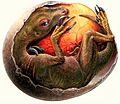Therizinosaur facts for kids
Quick facts for kids TherizinosaursTemporal range: Cretaceous, 130–65.5 mya, possible Lower Jurassic record
|
|
|---|---|
 |
|
| Reconstructed skeleton of Nothronychus | |
| Scientific classification | |
| Kingdom: | |
| Class: | |
| Superorder: | |
| Order: | |
| Suborder: | |
| Infraorder: | |
| Superfamily: |
Maniraptoria
|
Therizinosaurs (also called segnosaurs) were a special group of dinosaurs. They belonged to a larger group called theropods. Most theropods were meat-eaters, like the famous T-Rex. But therizinosaurs were different! They seemed to be plant-eaters, or herbivores.
Scientists have found therizinosaur fossils in places like Mongolia, People's Republic of China, and Western North America. These fossils date back to the Cretaceous period. By studying their bones, especially their arms, skulls, and hips, scientists could tell they were theropods. They were also close relatives of birds, belonging to a group called maniraptorans.
Contents
Discovering Therizinosaurs
When scientists first found therizinosaur fossils, they were a bit confused. The bones looked very strange! They had features from different types of dinosaurs. Some parts looked like theropods, which are usually meat-eaters. Other parts looked like prosauropods or ornithischians, which were often plant-eaters.
Because of this mix of features, some scientists first thought therizinosaurs were a very old, simple type of dinosaur that survived longer than expected. It took a while to figure out their true identity.
Unraveling the Mystery
The real breakthrough happened in the mid-1990s. This is when scientists finally agreed that therizinosaurs were actually plant-eating descendants of meat-eating theropods.
A key discovery was Alxasaurus. This dinosaur had more typical theropod features. It helped scientists connect the dots. Then, they realized that Therizinosaurus, a dinosaur known for its huge claws, was also part of this segnosaur group.
The link between therizinosaurs and other theropods became even clearer with later discoveries. In 1999, Beipiaosaurus was found. Then, in 2005, Falcarius was discovered.
The "Missing Link" Dinosaur
The scientists who studied Falcarius noticed something amazing. It seemed to be a "missing link" between meat-eating and plant-eating theropods. It showed how some predatory maniraptorans might have slowly changed into the plant-eating therizinosaurs.
Even though therizinosaurs are now classified as theropods, their skulls looked a bit like those of sauropods. Sauropods were giant, long-necked plant-eaters. The shape of the therizinosaurs' teeth and jaws also strongly suggests they were herbivores. They used their unique mouths to munch on plants.
Images for kids
-
Forelimbs of Therizinosaurus, specimen IGM 100/15 displayed at Nagoya City Science Museum
-
Reconstructed pelvis and metatarsus of the holotype of Segnosaurus, which together with Erlikosaurus became the basis of the new infraorder Segnosauria; this group is now a synonym of Therizinosauria
-
Partial forelimb of the basal therizinosaur Beipiaosaurus with impressions of feather structures, Paleozoological Museum of China
-
Hips from different genera
-
Outdated restoration of a prosauropod-like, quadrupedal Erlikosaurus. Therizinosaurs were often depicted this way until they were definitively identified as theropods
See also
 In Spanish: Therizinosauria para niños
In Spanish: Therizinosauria para niños









